Exochorda racemosa
A deciduous shrub up to 4m high, with arching stems and narrowly obovate green leaves to 7cm long, sometimes serrated at the tips. Produces upright clusters of relatively large, pure white flowers from rounded buds in spring
Size
Ultimate height
2.5–4 metresTime to ultimate height
5–10 yearsUltimate spread
2.5–4 metresGrowing conditions
Moisture
Moist but well–drainedpH
Acid, NeutralColour & scent
| Stem | Flower | Foliage | Fruit | |
| Spring | White | Green | ||
|---|---|---|---|---|
| Summer | Green | |||
| Autumn | Green | |||
| Winter |
Position
- Full sun
- Partial shade
Aspect
East–facing or North–facing or South–facing or West–facing
Exposure
Sheltered Hardiness
H6Botanical details
- Family
- Rosaceae
- Native to GB / Ireland
- No
- Foliage
- Deciduous
- Habit
- Bushy, Spreading branched
- Genus
Exochorda are bushy deciduous shrubs with simple, pale green leaves and saucer-shaped, 5-petalled white flowers in terminal racemes in spring or summer
- Name status
Correct
- Plant range
- China
How to grow
Cultivation
Grow in fertile, moist but well drained soil, in sun or dappled shade. Good as a specimen plant or in a shrub border. Does not do well on shallow chalk.
Propagation
Propagate by seed, sown in a seedbed in autumn, or by softwood cuttings in summer
Suggested planting locations and garden types
- City and courtyard gardens
- Cottage and informal garden
- Low Maintenance
- Flower borders and beds
Pruning
Pruning group 2, after flowering
Pests
Generally pest-free
Diseases
May be susceptible to honey fungus (rarely)
Get involved
The Royal Horticultural Society is the UK’s leading gardening charity. We aim to enrich everyone’s life through plants, and make the UK a greener and more beautiful place.
